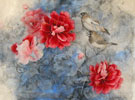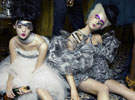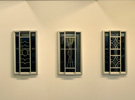一
……俸正杰的人物解剖试图分析汹涌而至的当代生活和通俗文化。而对时尚和明星,这些由大众媒介传达、煽动的热情,画家惶然退踞,他从分析鲁本斯笔下那些肉感而不无神性的女人人手,开始解析城市生活中各种面孔:演员的、歌星的、师友的、自己的。这些面孔有的价值连城,有的不值分文,但一张张煽情或不煽情的假面,却只有千篇一律和毫无生气的额肌、鼻肌、皱眉肌、唇三角肌,等等。人在表象上的差别性的确令人困惑,但人在本质上的一致性更令人恐惧。
…Feng Zhengjie’s personality anatomy intends to analyze the approaching of modern life and popular culture. While as for fashion or stars which were conveyed and instigated by the mass media, Feng retreated with fears. Starting from analyzing Rubens’ sensual and deiform women, he anatomized various faces in the city life: faces of actors, characters, teachers, friends and himself. Some of the faces are invaluable; some valueless. Each and every face, no matter exciting or glassy-eyed, boils down to standard muscles of forehead, nose, eyebrow, lips and etc. Human’s apparent distinctions indeed show perplexity, however, the substantially coherence is in itself even more horrifying.
——王林:《切入生活——关于解剖系列》(1992年)
Wang Lin, Cut-in Life – About Anatomy series, 1992
二.
一个成熟的艺术家总会熟练地把握作品指向的藏与露,过于隐匿含义会使观者如坠五里雾中,百思不得其解(当然,值得观众“百思”的作品非常难得);反之,过于直白的作品令人乏味,甚至有低估观众智商之嫌。好的作品应当在藏与露之间掌握住微妙的平衡,这有如锻造工把握淬火最佳时间的玄妙。
A mature artist can always control the obscurity and clarity of the intentions in his works skillfully. Too obscure meaning makes viewers dizzy and misunderstand even if they think hard (of course the works which are worth thinking hard by viewers are rare); conversely, too clear works are dull, and are even misunderstood to underestimate viewers’ intelligence. In his good works, an artist should seize the subtle balance between clarity and obscurity, just like a forger to seize the right time to quench steel.
俸正杰的《皮肤的叙述》作为系列组画,历时近两年的数十幅作品勾勒出了一个逐渐把握藏与露关系的渐进轨迹……《世纪的图腾》——充满画面的女人体。如果纯然是人体横陈,这方式最简单却一览无余;而俸正杰的办法是在交响的深粉红背景上突出了一块亮色,在明亮的天空中漂浮着班驳的肢体躯干,这块亮色成为作品的“画眼”。在阳光灿烂的社会认同、趋之若骛的心理情结背后,潜藏着女性的欲望、女性的苦衷、女人与生俱来的种种难以言表的情状,作者的处理方式是将其搅成一团,模糊轮廓,以反视出画面中的亮色,点点散落的花蕊又帮助营造了气氛,作者的指向的藏与露在此达成了一种微妙的平衡。
As a series of dozens of works prepared within two years, Feng Zhengjie’s ‘Recounting of Skin’ has drawn the outline of the gradual track of seizing the relation between obscurity and clarity…Totem of the Century---Female nudes filled in the painting. If it is just to exhibit nudes, this way is the simplest but takes in everything at a glance, while what Feng Zhengjie has done is to stress a light area in the symphonic dark peach background. The light area becomes the key of the painting. Women’s desires and difficulties, women’s many natural states of affairs which are hard to mention, have hidden potentially behind the sunny social approvement and psychological phenomenon of scrambling. The painter has mixed all these together to form an obscure contour, so as to contrast the light in the painting. And the scattered petals are helpful to the atmosphere. Here the obscurity and clarity of the painter’s intentions have come to a subtle balance.
——顾丞峰:《 阳光之下的秘密——关于俸正杰作品〈皮肤的叙述〉》(1996年)
Gu Chengfeng, Secret in the Sun - Concerning Feng Zhengjie’s works ‘Recounting of Skin’, 1996
三
俸正杰的作品始终有很强的观念性,他的画面不是显示场景的描绘,而是经过简化和平面化处理的意象,并不时加入些组合性的小画面,以造成反差增加感觉的难度。直面他的作品人们自然会想到爱滋病之类人类享乐文化带来的结果,其实又何尝不能体会到精神对现实的反应,正是艺术家精神上的“过敏反应”在提醒人们:不能在习以为常的生活中沉没。美丽肌肤的溃烂是触目惊心的,而俸正杰的把握正是要描画出美丽的触目惊心,所以他并不去渲染疮疤的丑陋,这种对感官的控制,现看俸正杰的创作思路:既不赞美美人也不亵渎人,而是用突出一点的方式提示人。这种抓住一点,不尽其余的自择性,这种和现实生活保持距离的反省心理,使后生代的创作既不同于八五时老哥萨克,又不同于八九后新生代。但坦率说,他们和八五时代有更多的相同之处。
Feng Zhengjie’s works have a very strong sense of idea. His paintings present not scenes of reality, but simplified and planar images. Once in a while some little combined pictures are added to produce contrast and to increase the difficulty of feeling. Facing his works, people will naturally think of the results by pleasure-seeking culture like Aids. In fact how can people not experience the experience the reaction to reality in spirit! It Is just the artist’s ‘allergic reaction’ in spirit that reminds of people not to sink into the habitual life. The ulcerating of beautiful skin is startling, while Feng is just to depict the beautiful shocking, so he doesn’t play up the ugliness of scars. The controlling over sense organ shows Feng’s creative train of thought which is neither to praise nor to profane, but to reveal man in away stressing one point. It is the self-choice of holding one point and abandoning others, the self-questioning psychology which keeps at a distance from reality, that make the creations of Post-New Generation both different from that of Old Russianists in 1985 and from that of New Generation after 1989. However, frankly speaking, they have more common points with those in 85 times.
——王林:《敏感的艺术,敏感的人——俸正杰油画作品序》(1996年)
Wang Lin, Sensitive Art, Sensitive Man——Preface of Feng Zhengjie’s oils, 1996
四
最近的作品, “艳若桃李”的语符逐渐演变成画面的象征提示与点缀,或是一朵马蹄莲,或是几朵小莲花,或是繁华的城市夜景等等。而溃烂斑斑的人体愈来愈成为画面主体形象,甚至连背景也变成充满晃动、不安的溃烂的人肉世界。晃动感背景的处理是俸正杰把表现性提升为画面重要手段,减弱了前期作品中装饰感和冷静的象征性……
In his latest works, the language symbol which is ‘gaudy as a peach/plum’ has gradually become symbolic prompting and ornament of the painting, such as a lily-of-the-valley, or some little lotus flowers, or flourishing metropolis night scenery and so on. And the ulcerative nudes are increasingly becoming the main image of the painting, even the background has become a rocking, uneasy and ulcerative corporal world. The handing of rocking background is the important method that Feng used to promote expressionism into his paintings, and to decrease the decorationism and sober-minded symbolism in his previous works…
我们从作者以艳丽与溃烂的因果联系的话语中,最直接感受到的是与性的世界联系,在艳丽、喜庆背后是性、艾滋带给这个世界的灾难。但这只是一个象征,它背后借喻的是一个预言,或是我们生活在其中这个世界的一个意象,一个带给我们愉快的浮艳的世俗世界的意象——虽“艳若桃李”,却是“溃烂之处”。事实上,艺术家正是对我们今天生存处境的良知和敏感,当我们不得不面对这个精神破碎的时代时,我们正走进一个浮华与艳丽的世俗欲望世界。
From the causality language of gaudiness and ulceration, we can have a direct feeling of sexuality relating to the world. Behind gaudiness and jubilation is the disaster which sexuality and AIDS have been bringing to the world. Yet it is only a symbol behind which is a metaphorical prediction, or an image of the world we live in, an image of gaudy common world that brings us happiness—although being ‘gaudy as a peach/plum’, it’s ‘ulcerative’. In fact, it is the artist’s intuitive knowledge and sensitivity, that when we have to face the spirit-broken times, we are entering a showy and luxurious, gaudy and common world full of desires.
——栗宪庭:《溃烂之处,艳若桃李——序俸正杰〈皮肤的叙述〉系列作品》(1996)
Li Xianting, Ulcer being Gaudy as a Peach/Plum - Preface of Feng Zhengjie’s serial works Recounting of Skin, 1996
五
俸正杰的粉红粉绿转换成具有时尚和象征意味的色彩,和他的平面化,带点腻味的轻柔和平滑的笔触,流畅的线条,以及装饰感,整体上形成一种快乐、漂亮、妩媚、鲜艳、肤浅、脆弱……的趣味,创造性地再造了上世纪初的中国月份牌美人画式的感觉。其实,月份牌年画在1920-40年代,本是当时的时尚,但不能登大雅之堂,连当时主张艺术通俗化的陈独秀都极其鄙视月份牌年画。终于,月份牌在1950-70年代登上了中国国家展览的殿堂,而如今俸正杰的美人画,所以能登大雅之堂,在于转换,在于作者对中国今天时尚和消费文化的审视――爱其漂亮痛其肤浅的矛盾但诚实的感觉,把一张张美人的脸庞,仿佛变成一个个充满感官享受的当代中国人的心理肖像。
Feng Zhengjie’s red and green can be read as fashionable and meaningful colors. Together with the complanation, the soft and smooth strokes, the floating lines and the decorating effect of his paintings, they create a kind of happiness, beauty, charm, brightness, shallowness and weakness… creatively reconstructing the feeling of calendar picture in last century. Calendar picture was fashionable from 1920s to 1940. However, it was never regarded as a part of high end arts. Even Chen Duxiu, who claimed popularization of art, looked down on it. Calendar picture finally got into the national exhibition from 1950s to 1970s. Transformation and Feng Zhengjie’s thinking on today’s fashion and culture of consumption make his works accepted as high end art. The pretty yet shallow feeling is honest and complex, turning faces of beautiful girls into mental portraits of Chinese today, who concentrate on joy and comfort.
——栗宪庭:《“新月份牌”风格的创造——俸正杰作品简说》(2008)
Li Xianting, Style of “new calendar picuture” – Works of Feng Zhengjie, 2008
六
俸正杰先生在四川美术学院上学的时候我就开始接触他,那个时候中国的消费文化刚刚发生,他当学生时画的一些作品就开始解剖消费文化。然后随着他的毕业一直到现在,十几年过去了,他创造了一个消费文化的经典。这个经典是包含着中国传统文化过节的大红大绿,喜庆的色彩;也和中国二十世纪三十年代的上海月份牌年画那种造型方法一脉相承。他把这种文化逐渐融入到当代的感觉当中,创造出这样一种粉红粉绿的大美人头。
I got to know Mr. Feng Zhengjie since his education at Sichuan Academy of Fine Arts, He had produced a number of works to anatomise the emerging China's consumer society at that time. More than 10 years till his graduation, he has created a consumer society spectrum. This spectrum presented by festive colours red and green in traditional Chinese culture; he also drew upon the pictures of Shanghai’s calendar in 1930s. Gradually he have integrated the art into contemporary society, and created such colourful women portraits.
——栗宪庭:在新加坡美术馆俸正杰个展《本色》开幕式上的讲话 (2008)
Li Xianting, SPEECH AT THE EXHIBITION OPENING OF PRIMARY COLOURS




